Abolitionism in the United Kingdom facts for kids
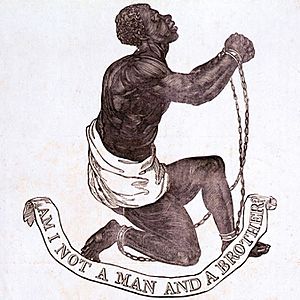
Abolitionism in the United Kingdom was a big movement in the late 1700s and early 1800s. Its main goal was to completely stop slavery in the United Kingdom, across the entire British Empire, and eventually worldwide. This included ending the Atlantic slave trade, which was the buying and selling of enslaved people across the Atlantic Ocean. This movement was part of a larger effort against slavery happening in Western Europe and the Americas.
The buying and selling of enslaved people became illegal across the British Empire in 1807. However, owning enslaved people in overseas colonies was still allowed until 1833. After 1833, enslaved people became "apprentices" to their former owners. This meant they had to work for them for a few more years. Most of them gained full freedom by 1840, and the last few by 1843.
Contents
How the Anti-Slavery Movement Started
In the 1600s and early 1700s, groups like the English Quakers and some other religious people said that slavery was wrong. They believed it went against Christian teachings. Some thinkers from the Enlightenment also argued that slavery went against basic human rights.
One of the first people to act on these ideas was James Edward Oglethorpe. He convinced the government to ban slavery in his new colony of Georgia in America in 1735. However, slavery was brought back there in 1751. Oglethorpe also encouraged friends like Granville Sharp and Hannah More to fight against slavery. After he died, they joined William Wilberforce and others to form a group called the Clapham Sect.
In England itself, the slave trade had been banned way back in 1102 by a Church meeting. Later, in 1700, a judge named Sir John Holt famously ruled that "As soon as a man sets foot on English ground he is free." This meant that slavery was not officially recognized by English law.
However, British colonists still brought enslaved people to their North American colonies. By the 1700s, traders also started bringing enslaved people from Africa, India, and East Asia to cities like London and Edinburgh to work as servants.
Early Court Cases Against Slavery
Some of the first court cases in Britain to challenge slavery happened in Scotland. These cases, like Montgomery v. Sheddan (1755) and Spens v. Dalrymple (1769), involved enslaved people who had been baptized in Scotland. They argued that slavery was illegal. These cases helped set up how future legal challenges against slavery would work.
The legal situation for enslaved Africans in England was unclear until a famous case in 1772 called Somersett's Case. James Somersett was an enslaved man who escaped in London. His master, Charles Steuart, captured him and planned to send him to Jamaica to be resold. Somersett's friends got a special court order called a habeas corpus.
This meant that Lord Mansfield, the Chief Justice, had to decide if Somersett's capture was legal under English law. There was no specific law that made slavery legal in England. The case got a lot of attention, and many people supported Somersett.
On June 22, 1772, Lord Mansfield ruled that slavery was so terrible that it could only exist if there was a clear, specific law allowing it. Since no such law existed in England, he said, "the black must be discharged." This ruling was widely understood to mean that slavery was not allowed in England. Because of this decision, between 10,000 and 15,000 enslaved people in England gained their freedom by 1774. However, this ruling did not apply to British colonies overseas, where slavery was allowed by their local laws.
After hearing about Somersett's Case, an enslaved African named Joseph Knight, who had been bought in Jamaica and brought to Scotland, left his master. He went to court, arguing that he could not be held as a slave in Great Britain. In the case of Knight v. Wedderburn (1778), the Scottish court agreed with Knight. They ruled that slavery was not recognized under Scottish law.
These court cases worried the powerful plantation owners, known as the plantocracy. They formed the London Society of West India Planters and Merchants in 1780 to protect their interests. This group strongly fought against ending the slave trade and slavery itself.
Activists Organize Against Slavery
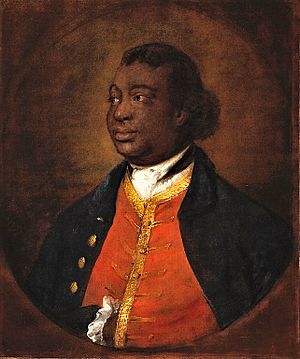
After the Somersett case, more people in Britain started to oppose slavery. In 1774, John Wesley, a leader of the Methodist movement, wrote a strong book called Thoughts Upon Slavery, criticizing the practice. A clergyman named Humphry Primatt wrote in 1776 that no "white man" had the right to enslave a "black man."
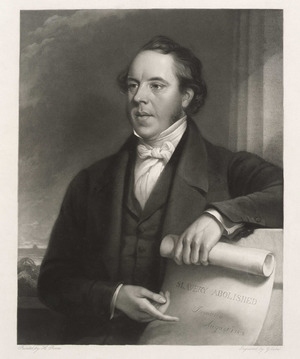
Even though slavery ended in Great Britain, it continued in the British colonies in the West Indies. British banks still helped fund the industries in these colonies that relied on slavery. In 1785, the poet William Cowper wrote about how England should extend its freedom to its colonies:
We have no slaves at home.—Then why abroad?
And they themselves once ferried o'er the wave
That parts us, are emancipate and loos'd.
Slaves cannot breathe in England; if their lungs
Receive our air, that moment they are free,
They touch our country and their shackles fall.
That's noble, and bespeaks a nation proud
And jealous of the blessing. Spread it then,
And let it circulate through ev'ry vein
Of all your empire. That where Britain's power
Is felt, mankind may feel her mercy too.
In 1783, the anti-slavery movement really began to grow in Britain. A group of Quakers started their first abolitionist organization. Quakers were very important throughout the entire campaign. On June 17, 1783, a Member of Parliament named Sir Cecil Wray presented the Quaker petition against slavery to Parliament. Also in 1783, Beilby Porteus, a Bishop, asked the Church of England to stop its involvement in the slave trade.
Africans themselves played a key role in the movement. In Britain, Olaudah Equiano, a former enslaved person, wrote a popular book about his life and worked tirelessly against the slave trade. Powerful images also helped the cause, like the famous Wedgwood anti-slavery medallion from 1787 and a drawing showing the terrible conditions on a slave ship called the Brookes.
The Movement Grows Stronger
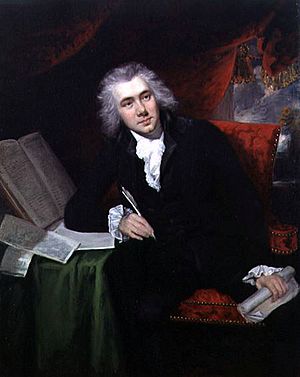
In 1787, the Committee for the Abolition of the Slave Trade was formed. William Wilberforce became the leader of the parliamentary campaign to end slavery. He eventually succeeded in getting the Slave Trade Act 1807 passed, which banned the slave trade in the British Empire. He continued to fight for the complete end of slavery, which he saw happen with the Slavery Abolition Act 1833.
The Atlantic slave trade, also called the Triangle trade, involved British merchants shipping goods from ports like Bristol and Liverpool to West Africa. There, they traded these goods for enslaved people. These enslaved people were then shipped to British colonies in the Caribbean or America. In these places, traders sold the enslaved people for goods like rum, sugar, tobacco, and rice, which they took back to Britain. This "triangle" of trade was very profitable.
Many people, both Europeans and Africans, worked to end the slave trade and slavery. Famous British abolitionists included James Ramsay, who had seen the cruelty firsthand; William Roscoe, a brave politician from Liverpool; Granville Sharp; Thomas Clarkson; and Josiah Wedgwood, who made the ""Am I Not A Man And A Brother?"" medallion. Other members of the Clapham Sect and Quakers were also very important.
Quakers made up most of the Committee for the Abolition of the Slave Trade. They were the first to ask the British Parliament to ban the slave trade. Since Quakers couldn't be Members of Parliament at that time, William Wilberforce, an Anglican, led the campaign in Parliament. Thomas Clarkson became the group's main researcher. He traveled widely, interviewing sailors and former enslaved people in British ports to gather evidence against the slave trade.
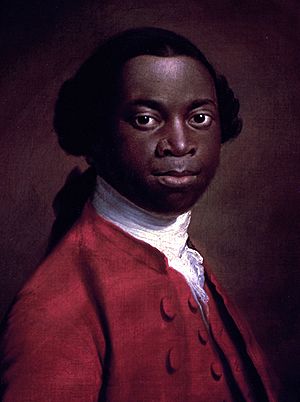
Thanks to Clarkson's efforts, a network of 1,200 local anti-slavery groups was set up across the country. These groups held public meetings, published pamphlets, and collected petitions. A petition in 1792 got 400,000 signatures, and one in 1814 got 1,375,000 signatures!
The autobiography of Olaudah Equiano, a freed enslaved person, was one of the first books promoted by the Committee. The movement also got support from other freed enslaved people and many religious groups like Swedenborgians, Quakers, Baptists, and Methodists. They even reached out to the new industrial workers in cities. Women and children, who usually weren't involved in politics, also joined the campaign, especially through a successful sugar boycott.
In 1792, after many petitions, the House of Commons voted to gradually abolish the slave trade. However, the House of Lords, another part of Parliament, stopped this decision.
Abolitionists also worked with African leaders to buy land for 'Freetown'. This settlement in Sierra Leone was for former enslaved people from the British Empire and the United States. Britain had promised freedom to American enslaved people who joined their side during the American Revolutionary War. Thousands of these "Black Loyalists" were moved to Nova Scotia, Canada. Later, many were offered a chance to move to Freetown. British influence in West Africa grew as they made agreements with local leaders to stop slave trading.
The Slave Trade Act of 1807
The Slave Trade Act was passed by the British Parliament on March 25, 1807. This law made the slave trade illegal throughout the entire British Empire. The West Africa Squadron of the Royal Navy helped enforce this act. The law set a fine of £100 for every enslaved person found on a British ship.
The Slave Trade Felony Act of 1811
Even after the 1807 Act, the profitable slave trade continued through smuggling. Sometimes, ship captains would even throw enslaved people into the sea if they thought the Royal Navy was about to catch them. Henry Brougham, an abolitionist and new Member of Parliament, realized that more needed to be done. He successfully introduced the Slave Trade Felony Act 1811.
This new law made slave trading a serious crime (a felony) throughout the British Empire and for British citizens anywhere in the world. This law was much more effective. The Royal Navy actively hunted down slave ships. In 1827, Britain even declared that taking part in the slave trade was piracy, which could be punished by death.
Between 1808 and 1860, the Royal Navy’s West Africa Squadron captured about 1,600 slave ships and freed 150,000 Africans who were on board. Britain also used its power to convince other countries to sign treaties to end their slave trade. They even allowed the Royal Navy to seize their slave ships. Britain also took action against African leaders who refused to stop the trade. For example, in 1851, they removed the king of Lagos who supported the trade. Britain signed anti-slavery treaties with over 50 African rulers.
The Slavery Abolition Act of 1833
After the 1807 Act, people could still own enslaved persons in the British Empire, even if they couldn't buy or sell them. In the 1820s, the abolitionist movement started campaigning again, this time to end slavery completely. In 1823, the first Anti-Slavery Society was formed in Britain. Its members included many non-conformist churches and people who had fought against the slave trade before.
In 1831, an enslaved man named Sam Sharpe led a large rebellion in Jamaica, known as the Christmas Rebellion or Baptist War. This event helped push anti-slavery feelings even further. The combination of political pressure and these uprisings convinced the British government that slavery had to end.
On August 28, 1833, the Slavery Abolition Act became law. This paved the way for slavery to be abolished across the British Empire and its colonies. On August 1, 1834, all enslaved people in the British Empire (except for India) were declared free. However, they had to work for their former owners as "apprentices" for a few more years. The first apprenticeships ended on August 1, 1838, and the last ones were supposed to end on August 1, 1840.
The apprenticeship system was very unpopular with the newly freed people. In Trinidad, on August 1, 1834, when the Governor tried to explain the new laws, the mostly elderly, unarmed crowd started chanting: "Pas de six ans. Point de six ans" ("Not six years. No six years"). Peaceful protests continued until the government decided to end the apprenticeship system early. Full freedom for all enslaved people was legally granted on August 1, 1838, making Trinidad the first British slave society to fully end slavery.
The government set aside £20 million to pay slave owners for their "property" (the enslaved people). However, formerly enslaved people did not receive any compensation or reparations. This was because the abolitionists focused on getting the law changed and believed that freedom itself was far better than continued slavery. To give you an idea of the amount, £20 million was a very large sum at the time.
Campaigning After the Act

In 1839, the British and Foreign Anti-Slavery Society was formed. At this time, Britain still imported a lot of cotton from the southern United States, where slavery was still used for cotton production. This cotton fueled British factories in cities like Manchester. British banks also lent money to everyone involved in this trade.
The British and Foreign Anti-Slavery Society campaigned to outlaw slavery in other countries. They also pushed the British government to do more to stop the slave trade, by treating slave traders as pirates. This organization still exists today as Anti-Slavery International, the world's oldest international human rights organization, based in London.
On December 20, 1841, the first international agreement to stop the slave trade was signed in London. Representatives from Austria, Britain, France, Prussia, and Russia signed this Treaty for the Suppression of the African Slave Trade. Later, Britain also signed a treaty with the United States in 1862.
See Also
- List of Abolitionist Forerunners (by Thomas Clarkson)
- Slavery in the British Isles
- Slavery in the British and French Caribbean
- Slavery in the British Virgin Islands
- Abolitionism in the United States
- Abolitionism in France




